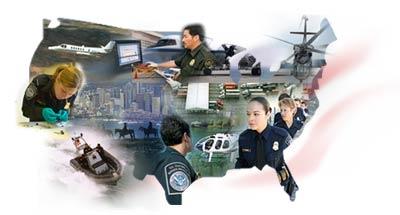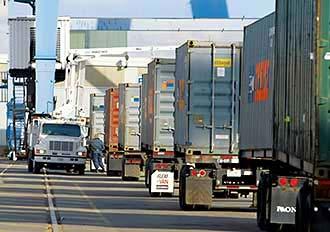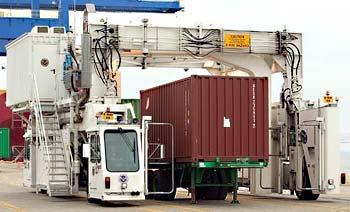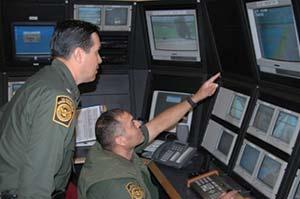 Protecting Our Borders Against Terrorism
Protecting Our Borders Against TerrorismU.S. Customs and Border Protection (CBP) is the unified border agency within the Department of Homeland Security (DHS). CBP combined the inspectional workforces and broad border authorities of U.S. Customs, U.S. Immigration, Animal and Plant Health Inspection Service and the entire U.S. Border Patrol.
CBP includes more than 41,000 employees to manage, control and protect the Nation’s borders, at and between the official ports of entry. “U.S. Customs and Border Protection has accomplished a lot to secure our borders, but there is much more we are doing. We understand that as America’s frontline, the security of a nation rests on our shoulders. We have learned the lessons of 9/11 and are working day and night to make America safer and more secure,” stated Commissioner Robert C. Bonner.
CBP "Twin Goals" - Anti-Terrorism and Facilitating Legitimate Trade and Travel
“For the first time in our nation's history, one agency has the lone responsibility of protecting our borders. As the single, unified border agency, CBP's mission is vitally important to the protection of America and the American people. CBP's priority mission is preventing terrorists and terrorist weapons from entering the United States, while also facilitating the flow of legitimate trade and travel,” continued Commissioner Bonner.
CBP uses multiple strategies and employs the latest in technology to accomplish its dual goals. CBP's initiatives are designed to protect the homeland from acts of terrorism, and reduce the vulnerability to the threat of terrorists through a multi-level inspection process.
Better Targeting
U.S. Customs and Border Protection assess all passengers flying into the U.S. from abroad for terrorist risk. We are able to better identify people who may pose a risk through initiatives such as: the Advance Passenger Information System (APIS), United States Visitor and Immigrant Status Indication Technology (US-VISIT), and the Student and Exchange Visitor System (SEVIS). CBP regularly refuses entry to people who may pose a threat to the security of our country. This was not a focus prior to 9/11, but a shift in priorities and the formation of U.S. Customs and Border Protection has made this the top priority of the agency – keeping terrorists and terrorist weapons out of the country.
In addition, CBP uses advance information from the Automated Targeting System (ATS), Automated Export System (AES), and the Trade Act of 2002 Advance Electronic Information Regulations to identify cargo that may pose a threat. CBP’s Office of Intelligence and the National Targeting Center (NTC) enhance these initiatives by synthesizing information to provide tactical targeting. Using risk management techniques they evaluate people and goods to identify a suspicious individual or container before it can reach our shores.
The Automated Commercial Environment (ACE) has made electronic risk management far more effective. The ACE Secure Data Portal provides a single, centralized on-line access point to connect CBP and the trade community. CBP's modernization efforts enhance border security while optimizing the ever-increasing flow of legitimate trade.
CBP also screens high-risk imported food shipments in order to prevent bio-terrorism/agro-terrorism. For the first time, U.S. Food and Drug Administration (FDA) and CBP personnel are working side by side at the NTC to protect the U.S. food supply by taking action, implementing provisions of the Bioterrorism Act of 2002. CBP and FDA are able to react quickly to threats of bio-terrorist attacks on the U.S. food supply or to other food related emergencies.
Pushing Our "Zone of Security Outward" - Partnering With Other Countries
U.S. Customs and Border Protection has created smarter borders by extending our zone of security beyond our physical borders.
CBP has established working groups with our foreign counterparts to establish ties, improve security and facilitate the flow of legitimate trade and travel. CBP has established the Container Security Initiative (CSI). Under CSI, CBP pushes the border outward by working jointly with host nation counterparts to identify and pre-screen containers that pose a risk at the foreign port of departure before they are loaded on board vessels bound for the U.S. With the addition of the Port of Piraeus, Greece this week, CSI is now implemented in 20 of the largest ports in terms of container shipments to the U.S.
CBP has implemented joint initiatives with our bordering countries, Canada and Mexico: The Smart Border Declaration and associated 30-Point Action Plan with Canada and The Smart Border Accord with Mexico. The Secure Electronic Network for Travelers' Rapid Inspection (SENTRI) allows pre-screened, low-risk travelers from Mexico to be processed in an expeditious manner through dedicated lanes. Similarly, on our northern border with Canada, we are engaging in NEXUS to identify and facilitate low-risk travelers. Along both borders, CBP has implemented the Free and Secure Trade (FAST) program. The FAST program utilizes transponder technology and pre-arrival shipment information to process participating trucks as they arrive at the border, expediting trade while better securing our borders.

In addition, an agreement with Canada allows CBP to target, screen, and examine rail shipments headed to the U.S. This month, CBP is establishing CBP attachés in Mexico and Canada to coordinate border security issues. CBP Border Patrol agents, the Royal Canadian Mounted Police, and the Drug Enforcement Administration, as well as state and local law enforcement agencies from Canada and the U.S. have joined together to form fourteen Integrated Border Enforcement Teams (IBET). Covering our entire mutual border with Canada, these teams are used to target cross-border smuggling between Canada and the United States. The teams focus on criminal activity such as smuggling of drugs, humans, contraband and cross-border terrorist movements.
Pushing Our "Zone of Security Outward" - Partnering With the Private Sector
Processing the sheer volume of trade entering the U.S. each year requires help from the private sector. The Customs-Trade Partnership Against Terrorism (C-TPAT) is a joint government-business initiative designed to strengthen overall supply chain and border security while facilitating legitimate, compliant trade. To date, over 6,500 companies are partnering with CBP. C-TPAT is the largest, most successful government-private sector partnership to arise out of 9-11.
In addition, U.S. Customs and Border Protection is piloting the Advanced Trade Data Initiative. This program works with the trade community to obtain information on U.S. bound goods at the earliest possible point in the supply chain. Partnering with carriers, importers, shippers and terminal operators, we are gathering supply chain data and feeding it into our systems to validate container shipments during the supply process. This information increases CBP’s existing ability to zero in on suspect movements and perform any necessary security inspections at the earliest point possible in the supply chain.
Inspection Technology and Equipment
Given the magnitude of CBP's responsibility the development and deployment of sophisticated detection technology is essential. Deployment of Non-Intrusive Inspection (NII) technology is increasing and viewed as "force multipliers" that enable CBP officers to screen or examine a larger portion of the stream of commercial traffic.
CBP does not rely on any single technology or inspection process. Instead, officers and agents use various technologies in different combinations to substantially increase the likelihood that terrorist weapons including a nuclear or radiological weapon will be detected and interdicted.
Technologies deployed to our nation's land, sea, and airports of entry include large-scale x-ray and gamma-imaging systems. CBP has deployed radiation detection technology including Personal Radiation Detectors (PRDs), radiation isotope identifiers, and radiation portal monitors. CBP uses trained explosive and chemical detector dogs. CBP's Laboratories and Scientific Services Fast Response Team reacts to calls on suspicious containers. The Laboratories and Scientific Services also operates a 24 hours, 7 days a week, 365 days a year hotline at its Chemical, Biological, Radiation, and Nuclear Technical Data Assessment and Teleforensic Center.
Keeping Weapons and Money from Falling into Terrorist Hands – Outbound Inspections
U.S. Customs and Border Protection has the authority to search outbound, as well as in bound shipments, and uses targeting to carry out its mission in this area. Targeting of outbound shipments and people is a multi-dimensional effort that is enhanced by inter-agency cooperation. CBP in conjunction with the Department of State and the Bureau of the Census has put in place regulations that require submission of electronic export information on U.S. Munitions List and for technology for the Commerce Control List. This information flows via the Automated Export System (AES). CBP is also working with the Departments of State and Defense to improve procedures on exported shipments of foreign military sales commodities. CBP also works with Immigration and Customs Enforcement (ICE) to seize outbound currency, particularly cash and monetary instruments going to the Middle East.
Protecting the Miles of Open Border Between Official Ports of Entry
U.S. Customs and Border Protection’s Border Patrol agents are better securing areas between the ports of entry by implementing a comprehensive border enforcement strategy, expanding, integrating, and coordinating the use of technology and communications through:
“U.S. Customs and Border Protection can point to a myriad of accomplishments since 9/11 to better secure our Nation’s borders. They are astonishing in scope and the speed with which we have implemented them. Our borders are more secure than they were on 9/11 -- keeping terrorists and their weapons out of our country is the most vital mission of any law enforcement agency – a mission we must succeed at,” stated Commissioner Bonner.






